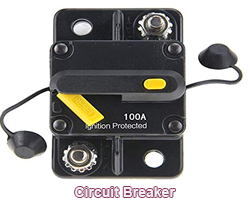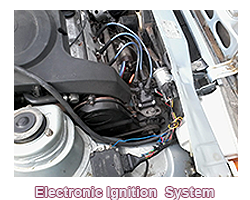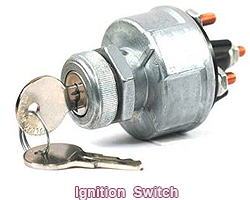
AUTOIGNITION: Describes the rapid burning of the air-fuel mixture not through a spark plug but as a result of contact with a hot surface.
ADVANCE:  Describes the procedure of changing a vehicle’s ignition timing so that the spark occurs earlier in the cycle.
Describes the procedure of changing a vehicle’s ignition timing so that the spark occurs earlier in the cycle.
BASIC IGNITION SETTING: Describes the situation where the ignition setting on a non-running engine that has been set according to the manufacturer’s specifications. Once the engine is running, the timing can be more accurately set.
BREAKER CAM: Describes the lobed cam rotating in the ignition system which interrupts the primary circuit to induce a high-tension spark for ignition.
BREAK TIME: Describes the length of time the contact breaker points remain open.
CONVENTIONAL IGNITION SYSTEM: Describes a type of ignition system consisting of the battery, ignition switch, ballast resistor, ignition coil, distributor, contact breaker points, condenser, centrifugal advance unit, vacuum advance unit, spark plugs and high-tension wires.
DIRECT IGNITION SYSTEM(DIS): Describes an ignition system which does not use a distributor but instead carries high voltage from the ignition coils directly to the spark plugs.
DYNAMIC IGNITION TIMING: Describes a scenario that occurred before the introduction of a strobe light, when ignition timing was carried out in a static situation with the distributor moved a certain measured amount. With modern engines, a timing light or strobe light is used.
DWELL: Describes a situation in a contact breaker ignition system where the number of degrees the breaker cam rotates from the time the breaker points close until they open again.
DWELL PERIOD: Describes the time during which the primary circuit is closed and primary current flows through the ignition coil. The dwell period can be defined in crankshaft or distributor shaft degrees.
ELECTRONIC IGNITION SYSTEM: Describes an ignition system using electronic switching devices to assist or eliminate the mechanical breaker points.
ELECTRONIC AIR CONTROL VALVE (EACV) Describes a valve used in a fuel-injection system, usually computer controlled, that controls the amount of air bypassing the throttle during idle. The more air that bypasses the throttle, the higher the idle speed.
FOUR-SPARK IGNITION COIL: Describes an ignition coil with two primary windings and one secondary winding.
GRID-CONTROLLED IGNITION SYSTEM: Describes a microprocessor-controlled ignition system with its electronic ignition timing by means of an ignition map stored in the control unit memory.
HIGH ENERGY COIL: Describes a coil which generates higher ignition voltage.
IGNITION: Describes the process which initiates the combustion of the compressed air/fuel mixture in a vehicle’s combustion chamber.
IGNITION SYSTEM: Describes the system that provides the electrical current or spark to ignite the air-fuel mixture in the combustion chambers. The system tales in the battery or magneto which sends electricity to the ignition coil when the ignition switch is turned on.
IGNITION CABLE: Describes the high-voltage cables in a vehicle’s ignition system, running from the ignition coil to the distributor and from the distributor to the spark plugs.
IGNITION COIL: Describes a form of pulse transformer which is an integral part of the ignition system. The coil receives a small amount of electrical voltage from the battery that steps up a pulse of low "primary" voltage, amplifying it into a major jolt of voltage of about 20,000 volts, which is transmitted to the spark plugs via the distributor.
IGNITION CONTROL UNIT: Describes a unit that controls electronic ignition systems, usually through current and dwell angle control.
IGNITION DELAY: Describes the minute time lag between ignition triggering and the production of a spark
IGNITION DISABLER: Describes a standard feature of car alarm systems that will disable the ignition in the case of interference.
IGNITION KEY: Describes the key used to switch on the car ignition
IGNITION LAG: Describes the time lag between fuel injection and combustion in a diesel engine
IGNITION MAP: Describes an electronic map usually stored in the electronic control unit of car ignitions fitted with electronic spark timing that contain the most favourable ignition angle/ignition point for every operating point of the engine.
IGNITION SWITCH: Describes the key operated control device that opens and closes an electrical current to initiate the ignition system through the battery
IGNITION TIMING: Describes a procedure that ensures that the spark coming from the spark plugs ignites the air-fuel mixture at exactly the right moment, pre-determined by the engine manufacturer of the engine, Incorrect ignition timing will inevitably result in excessive fuel consumption and below standard engine performance.
IGNITION VOLTAGE:  Describes the voltage level at which the spark jumps across the electrodes with 30,000 volts being normal today. Fifties and Sixties cars could be ignited by a jolt of 20,000 volts.
Describes the voltage level at which the spark jumps across the electrodes with 30,000 volts being normal today. Fifties and Sixties cars could be ignited by a jolt of 20,000 volts.
INTEGRATED DIRECT IGNITION SYSTEM (IDI): Describes a distributor less ignition system that consists of two separate ignition coils, an ignition module, a secondary conductor housing mounted to an aluminium cover plate, a crankshaft sensor and electronic spark timing.
AE4


